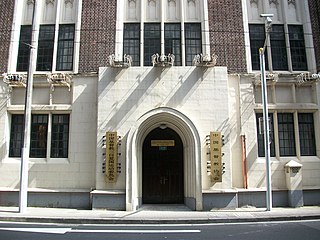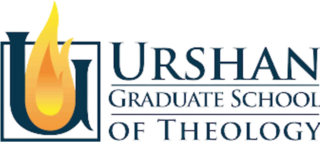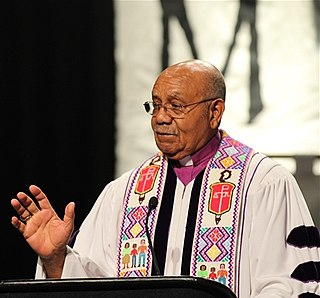
The United Church of Christ (UCC) is a socially liberal mainline Protestant Christian denomination based in the United States, with historical and confessional roots in the Congregational, Restorationist, Continental Reformed, and Lutheran traditions, and with approximately 4,600 churches and 712,000 members.The UCC is a historical continuation of the General Council of Congregational Christian churches founded under the influence of New England Puritanism. Moreover, it also subsumed the third largest Calvinist group in the country, the German Reformed. Notably, its modern members' theological and socio-political stances are often very different from those of its predecessors.

The China Christian Council was founded in 1980 as an umbrella organization for all Protestant churches in the People's Republic of China with Bishop K. H. Ting as its president. It works to provide theological education and the publication of Bibles, hymnals, and other religious literature. It encourages the exchange of information among local churches in evangelism, pastoral work and administration. It has formulated a church order for local churches, and seeks to continue to develop friendly relations with churches overseas.
Evangel University is a private Christian university and seminary in Springfield, Missouri. It is affiliated with the Assemblies of God Christian denomination, which is also headquartered in Springfield. The campus sits on 80 acres that were originally part of O'Reilly General Hospital.
Pilgrim Holiness Church (PHC) or International Apostolic Holiness Church (IAHC) is a Christian denomination associated with the holiness movement that split from the Methodist Episcopal Church through the efforts of Martin Wells Knapp in 1897. It was first organized in Cincinnati, Ohio, as the International Holiness Union and Prayer League (IHU/IAHC). Knapp, founder of the IAHC, ordained and his Worldwide Missions Board sent Charles and Lettie Cowman who had attended God's Bible School to Japan in December 1900. By the International Apostolic Holiness Churches Foreign Missionary Board and the co-board of the Revivalist the Cowmans had been appointed the General Superintendents and the Kilbournes the vice-General Superintendent for Korea, Japan and China December 29, 1905. The organization later became the Pilgrim Holiness Church in 1922, the majority of which merged with the Wesleyan Methodists in 1968 to form the Wesleyan Church.
Jesse Moren Bader (1886–1963) was a 20th-century evangelist, ecumenist and global leader. He was a significant and visionary leader during the twentieth century, not only within his own communion, helping establish the World Convention of Churches of Christ but also within the wider church. This influence was not limited to the United States of America but extended to the Christian world.

The Interdenominational Theological Center (ITC) is a consortium of five predominantly African-American denominational Christian seminaries in Atlanta, Georgia, operating together as a professional graduate school of theology. It is the largest free-standing African-American theological school in the United States.

Asia-Pacific Nazarene Theological Seminary (APNTS) is a graduate-level theological institution located near Metro Manila in the Philippines. APNTS is a seminary in the Wesleyan theological tradition and affiliated with the Church of the Nazarene through its Division of World Mission. Its mission is to prepare "men and women for Christ-like leadership and excellence in ministries." Its institutional vision is: "Bridging cultures for Christ, APNTS equips each new generation of leaders to disseminate the gospel of Jesus Christ throughout Asia, the Pacific, and the world.

Urshan Graduate School of Theology (UGST) is a private seminary affiliated with the United Pentecostal Church International (UPCI) and located in Wentzville, Missouri. It opened in 2001 as a Oneness Pentecostal seminary.
William D. Morrow is a retired Pastor, District Superintendent for the Western Ontario District, General Superintendent of the Pentecostal Assemblies of Canada (PAOC), and President of Master's College and Seminary (MCS), a PAOC degree-granting institution. In partial retirement, he subsequently served as an Associate Pastor, Discipleship and Leadership at Evangel Pentecostal Church in Montreal until January 2016.
Tahlee Bible College (TBC) functioned for nearly 70 years as an interdenominational training centre situated at Tahlee, a 170-acre (0.69 km2) property on the shores of Port Stephens, Australia, less than one hour north of Newcastle and less than three hours north of Sydney.
The Japan Evangelical Lutheran Church or JELC is a Lutheran church in Japan. It currently has approximately 21,990 baptized members in 122 congregations nationwide.
Warren William Ost was the Presbyterian minister who founded A Christian Ministry in the National Parks (ACMNP) in 1952.
Christmas in August is an annual tradition in Yellowstone National Park. The celebration includes decorating Christmas trees, singing Christmas carols, and gift exchanges.

The United Church of Christ in the Philippines is a Christian denomination in the Philippines. Established in its present form in Malate, Manila, it resulted from the merger of the Evangelical Church of the Philippines, the Philippine Methodist Church, the Disciples of Christ, the United Evangelical Church and several independent congregations.
Stephen A. Hayner was an American Presbyterian minister who was the president of Columbia Theological Seminary, a professor, an author, and the former president of InterVarsity Christian Fellowship.
The National Council of Congregational Churches of the United States was a mainline Protestant, Christian denomination in the United States. Its organization as a denomination was delayed by the Civil War. Congregational leaders met again in Boston, Massachusetts in 1865, where they began to hammer out standards of church procedures (polity) and adopted a statement of faith, known as the Burial Hill Declaration. Denominational organization came in 1871 with formation of the National Council of Congregational Churches, which existed until its merger in 1931. In 1928, there were 5,497 Congregational churches in the U.S. with a membership of 939,130. These churches were served by 5,648 ministers.

Bishop Melvin G. Talbert was an American bishop in The United Methodist Church (UMC), the second largest Protestant denomination in the United States.

Christ Holy Church International A.K.A Odozi-Obodo is an independent African church founded by Prophetess Agnes Amanye Okoh in Nigeria in 1947.

William Sterling Cary was an American Christian minister. From 1972 to 1975, he was the first Black president of the National Council of Churches (NCC) in its history.








